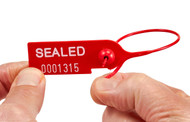The Usage of Tamper Evident Seals in Law Enforcement and Prisons
Posted by Steve Diebold
Though there is some debate about their use in the legal process, tamper-evident seals unquestionably serve an important function in the criminal justice system. As a matter of fact, many legal authorities and facilities have already explicitly developed protocols for sealing and safeguarding the necessary materials, like physical crime evidence, that are essential to the authenticity, security, and transparency of their criminal operations. However, uniform standards or criteria for doing so are still nonexistent.
Tamper Evident Seals Secure Evidence at Offsite Locations
In law enforcement, security seals are frequently used to ensure the legitimacy and validity of crime evidence and prevent it from being tampered with at every stage of the case trial. Commonly, the pieces of evidence are stored in sealed containments, such as envelopes, zip locks, vials, and bags. Each one is protected with tamper evident adhesive security labels or tapes.
Using security seals for crime evidence is difficult as it involves several different steps, which cannot all be discussed in this brief article. However, anyone who has ever watched a crime thriller on film or television can surely envision the different ways in which evidence is collected, recorded, transported, and preserved. Knowing this will make you understand how essential security seals are in crime evidence collection. With such wide usage, it is good to know that American Casting & Manufacturing provides a wide variety of security labels and tapes that you can choose from, with both standard and customized printing options.
Keeping evidence safe is a complicated task as it can be found in a wide variety of places, including crime scenes and during searches and seizures. Sealing immovable items, like doors, automobiles, huge objects, small objects' containers, samples, papers, and more, is made easier with the use of security tape or labels. Before being removed from a crime scene, computers and other necessary electronic equipment are routinely sealed, as are filing cabinets and other storage facilities.
Tamper Evident Seals Protect Evidence and Assets at Onsite Locations
In police stations, seals are used for compartments, vaults, storage areas, evidence rooms, and even frequently for labeling items that weren't sealed prior to arrival. In this case, it doesn't really matter what kind of seal you use. You may use any kind of seal here. Moreover, documents and other items from the crime scene must be stored in envelopes or bags bearing the original seal from the place of acquisition. However, once the pieces of evidence have been processed and reviewed, they are sealed again to ensure the integrity of the chain of custody. If evidence must be transported to a courthouse, this procedure must be repeated.
Firearms and drugs are usual examples of items that are frequently sealed in many ways with restricted access because of their great value as evidence. It's possible that they're locked away in a sealed container or locker within a restricted area. Moreover, the security seals can serve as proof of opening as well as a mechanism to record the last person to handle or affix a seal.
To ensure that supplies are kept, examined, and accessible only when necessary, police stations can use seals for more than just securing crime evidence. Tactical gear, ammunition, specialized weaponry, protective clothing, keys, and safety devices like flares are all examples of police assets where security seals can be utilized for storing. Another purpose is to restrict access to electronic controls and internal documents to only those with proper authorization.
Tamper Evident Seals in Correctional Facilities
Tamper evident seals are used in prisons and jails to protect the inmates, personnel, officials, and the establishment itself. As a standard practice, most prisons and jails require convicts to deposit their things in a locked box to ensure that only authorized personnel has access to them. The most common kind of seal for this purpose is the plastic pull-up variety. This may be used for long-term storage, but it is also convenient for packing away goods you need often.
In jail, inmates are constantly watched over and guarded. Items are numbered and inventoried on a regular basis since everything is susceptible to theft or embezzlement. Seals are placed on containers, carts, and other items entering and exiting a jail to prevent the insertion or removal of contraband or, in the worst case scenario, an inmate.
AC&M provides smooth pull tight seals solutions that are both universal and labeled for easy tracking and archiving for the purposes at hand. Or, we may create seals with a greater capacity for information, allowing you to record and verify the date, time, location, and identity of everyone who applies or uses the seal.
Get in touch with us if you have any inquiries regarding our seals or need more details on how to implement cable seals in your law enforcement operations. All of AC&M's seals are used by thousands of customers in industries as diverse as commerce, government, and the armed forces. If you need any advice, a sample, or a price quote, just let us know.
During regular business hours, you may speak with a seasoned professional who specializes in using seals. Our main headquarters and manufacturing facility may be reached via the email address info@seals.com. You may reach us at 516-349-7010 or toll-free in the US at 1-866-360-6748. As an alternative, you may visit our international sales and service locations page at www.seals.com.

